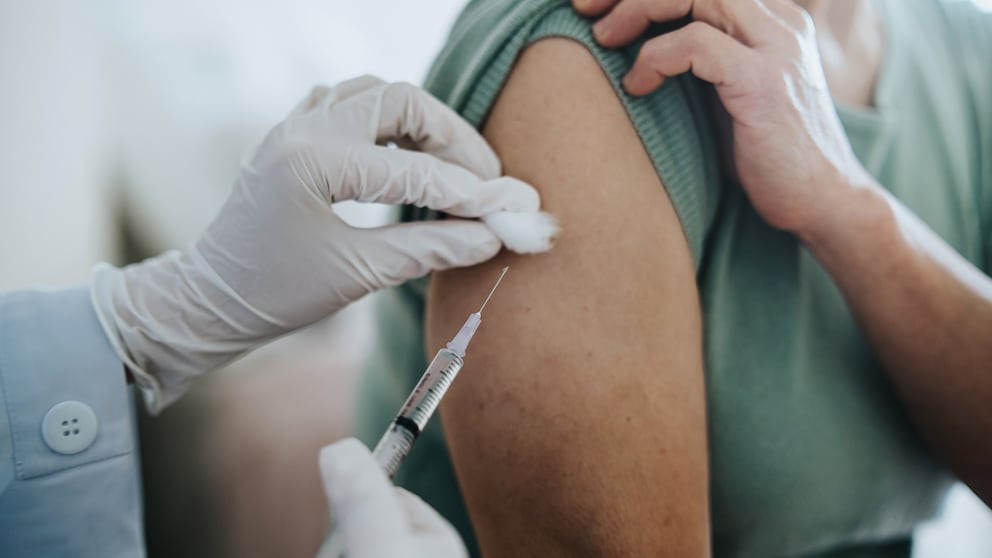January 1, 2025, 4:14 pm | Read time: 5 minutes
Researchers at Stanford have developed a method that elicits a strong immune response to several flu strains as well as avian flu. The newly constructed vaccine could potentially save millions of lives.
Based on model calculations, health authorities estimate that between 290,000 and 650,000 people worldwide die each year as a result of an infection caused by flu viruses.1 For Germany, the Robert Koch Institute gives widely varying figures ranging from several hundred to over 25,000 deaths.2 Older people and people with certain pre-existing conditions that weaken the immune system are particularly at risk. The best way to protect yourself and others against illness is to get the flu vaccine. This provides protection for around six to twelve months. Classic vaccines are then adapted annually to the influenza viruses currently circulating in order to offer the best possible protection for the coming season. However, these have gaps in protection – particularly against influenza subtypes. Researchers at Stanford University School of Medicine in California may have developed a way to close this gap and make the vaccines more effective. This would protect more people from the flu and prevent deaths.
Overview
- Effectiveness of the Flu Vaccine is Only 20 to 80 Percent
- The Researchers Sought to Determine: How Can the Flu Vaccine Be Made More Effective?
- Result of the Study: Newly Designed Vaccine Improved Antibody Response – Even Against Bird Flu Pathogens
- The Risk of an Avian Flu Pandemic Could Be Mitigated
- Sources
Effectiveness of the Flu Vaccine is Only 20 to 80 Percent
A team led by Mark Davis, Professor of Microbiology and Immunology at Stanford University, has developed a new method for influenza vaccination. They modified a vaccine so that it promoted an immune response to all four common influenza subtypes. This could increase the effectiveness of the vaccine. The research results were published in the journal Science.3
The seasonal vaccine contains virus strains from different subtypes that are grown independently and then combined. It helps by preparing the immune system for a faster and stronger response. Antibodies are a crucial part of this defense. These are special proteins that bind to the flu virus. If the antibodies adhere properly, they prevent the flu virus from entering the cells and multiplying there.
However, the researchers write that most people’s immune systems react more strongly to one of these strains. This makes them more susceptible to infection from others. Many vaccinated people have then not developed sufficient antibodies against the flu viruses. “However, the effectiveness of the vaccine is not as high as it could be. In recent years, its effectiveness has been between about 20 and 80 percent,” Davis said.
The Researchers Sought to Determine: How Can the Flu Vaccine Be Made More Effective?
To do this, they first had to identify the factors responsible for this strange blindness of the immune system against one subtype. Data from twins and vaccinated newborns helped them. The researchers write that the data showed that host genetics is the main driver of this bias.
Based on this, they hypothesized that putting the four antigens of the four common subtypes together could help the immune system. These are usually included separately in the vaccine mixture. So, they developed a vaccine that chemically combined the four hemagglutinins (antibodies). The concept is that now every B cell that recognizes one of the four subtypes will also engulf the other three. It then has all four on its surface, causing the immune system to react to all of them. However, under certain circumstances – genetics – it is not predisposed to do so.
Result of the Study: Newly Designed Vaccine Improved Antibody Response – Even Against Bird Flu Pathogens
In fact, the study showed that in mouse models, the new construct of the types improved the antibody response across several flu strains and their subtypes. The study also indicated a significant improvement in the antibody response to the worrisome avian flu. The immune response against avian influenza pathogens (avian influenza, i.e., influenza A viruses) is otherwise rather poor with seasonal flu vaccines.
Overall, the immune system produced a greater variety of T helper cells. These activate other specialized immune cells by recognizing their antigens. They then release messenger substances that stimulate antibody specialists, such as B cells or macrophages. B cells neutralize pathogens; macrophages devour them.

H5N1 Is the Risk of a Bird Flu Pandemic Increasing? This Is What an Expert Says

Study shows A severe coronavirus infection can possibly shrink cancer tumors

Post-Vaccination Syndrome Study Finds Possible Reason for Corona Vaccination Damage
The Risk of an Avian Flu Pandemic Could Be Mitigated
Is this discovery an innovation in the field of influenza vaccination? After all, they could also protect against potentially emerging flu strains with pandemic potential, the researchers write. “If we overcome subtype bias in this way, it may lead to a much more effective influenza vaccine that can even be applied to strains responsible for avian influenza,” Davis is quoted as saying.4
Some strains of bird flu have already been documented in Asia, Africa, and Europe. These include H5N1, which can lead to mass bird deaths and infect humans through close contact with infected birds or their droppings. Should the virus become efficiently transmissible between humans, it possesses the potential to initiate a pandemic.

